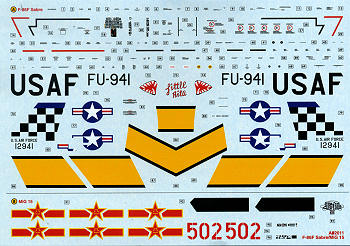
| KIT #: | A82011 |
| PRICE: | $17.99 SRP |
| DECALS: | One option per kit |
| REVIEWER: | Scott Van Aken |
| NOTES: | Two kits |

| HISTORY |
Korea was the first major conflict in which jet fighters fought each other in combat. Much has been said about the two protagonists in terms of which was the better aircraft. As with everything when doing comparisons, a few things have to be taken into consideration.
The first is the aircraft themselves. The MiG-15 was not as sophisticated an aircraft as the F-86. It was lighter, had less wing loading and had a more powerful armament. The F-86 was heavier, had superior electronics for the gun sight, and had better armor. The MiG-15 was a better dog-fighting aircraft thanks to its higher thrust to weight ratio and lower wing loading. It was unstable at very high speed. The heavier F-86 was able to dive better, and had a greater weight of fire from its faster firing .50 caliber machine guns than the MiG did with its three, slow firing cannon.
Next is the pilot. The major benefit of F-86 pilots was that they had a G-suit which kept them from blacking out in dog-fights. The MiG-15 pilot did not have this and so frequently blacked out during tight maneuvers, often resulting in a smoking hole in the ground. Secondly, F-86 pilots were brought into units in small numbers as experienced pilots rotated home. They had better in-country training and meanwhile experienced pilots were always out on patrol. The MiG-15 pilots, who were basically Soviet, were brought in en masse and so the learning curve for the unit had to start from scratch every time. This meant that the MiG pilots were tentative at first and after they had become seasoned, became better and better until it was time to leave and the cycle started all over again.
It also turns out that the kill ration is not as high as initially thought, which to anyone who has followed the subject should not be surprised to learn. So it really means that the aircraft were pretty similar with the airframe edge to the MiG and the pilot edge to the F-86.
| THE KIT |
Both of these kits have been reviewed elsewhere so a description of the plastic is not really necessary. Yes, that is pretty odd for a peek in the box, but if you have seen these new mold Airfix kits, there is really nothing new in this boxing. Here are a couple of build reviews so you can jog your memory. MiG-15 F-86
In fact, it is the boxing itself that is what is new. The kit is labeled "Airfix Club" Limited Edition. Now some editions are more limited than others, but regardless, this is a fine way to get two good kits and save a little bit in the bargain.
 Instructions are reprints from the standard boxing put into one booklet. Well drawn construction instructions continue the irritating trend of only offering Humbrol paint numbers, some of which need to be mixed. The markings for the F-86F is for 51-2941, which is an F-86F-5 named "Little Rita" as flow by Lt. D. Geiger with the 16th FIS in 1952/53. As the Airfix kit is a late F-86E/early F-86F, then the markings are appropriate for the kit. The MiG-15 is in Chinese markings and a very fetching scheme with upper green that has tan and black stripes. These stripes continued onto the wings and horizontal stabs. Decals are well done and should provide no issues. The yellow ID stripes are provided for the Sabre with the MiG section offering the wing walk areas. Both provide instrument panels as decals.
Instructions are reprints from the standard boxing put into one booklet. Well drawn construction instructions continue the irritating trend of only offering Humbrol paint numbers, some of which need to be mixed. The markings for the F-86F is for 51-2941, which is an F-86F-5 named "Little Rita" as flow by Lt. D. Geiger with the 16th FIS in 1952/53. As the Airfix kit is a late F-86E/early F-86F, then the markings are appropriate for the kit. The MiG-15 is in Chinese markings and a very fetching scheme with upper green that has tan and black stripes. These stripes continued onto the wings and horizontal stabs. Decals are well done and should provide no issues. The yellow ID stripes are provided for the Sabre with the MiG section offering the wing walk areas. Both provide instrument panels as decals.
| CONCLUSIONS |
This boxing is quite reminiscent of Airfix's old 'Dogfight Doubles' kit and I find it a great way to get two nice kits for a bit of a savings. Hope that they do this with other new tool kits. For those who do not have either of these kits, this would be a super way to obtain them. As they are 'limited', I am not sure how long they will be around or how many boxings were actually produced. They make very nice models so I can easily recommend them to modelers of all ages and skill levels.
March 2012
Thanks to me for procuring this one.
If you would like your product reviewed fairly and quickly, please contactme or see other details in the